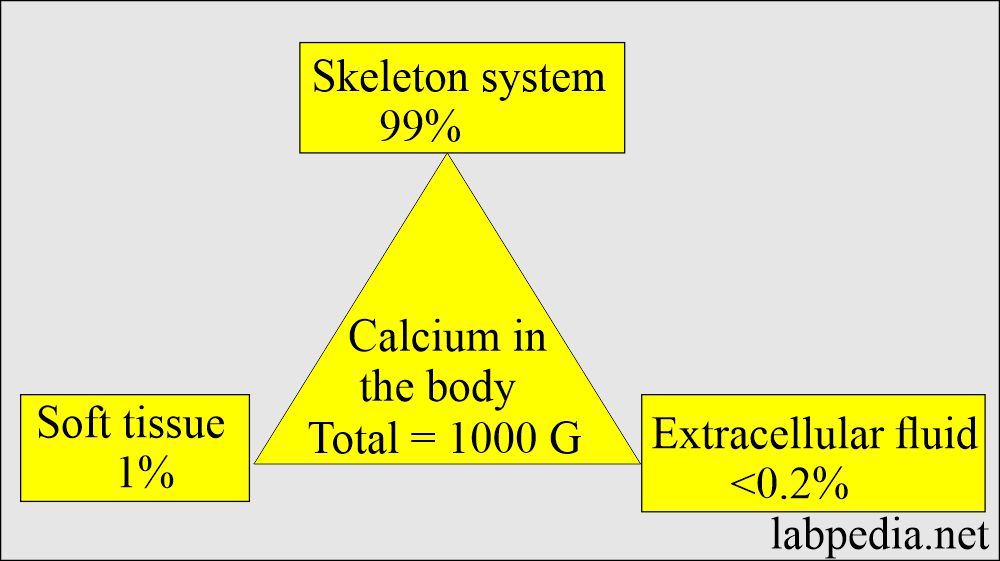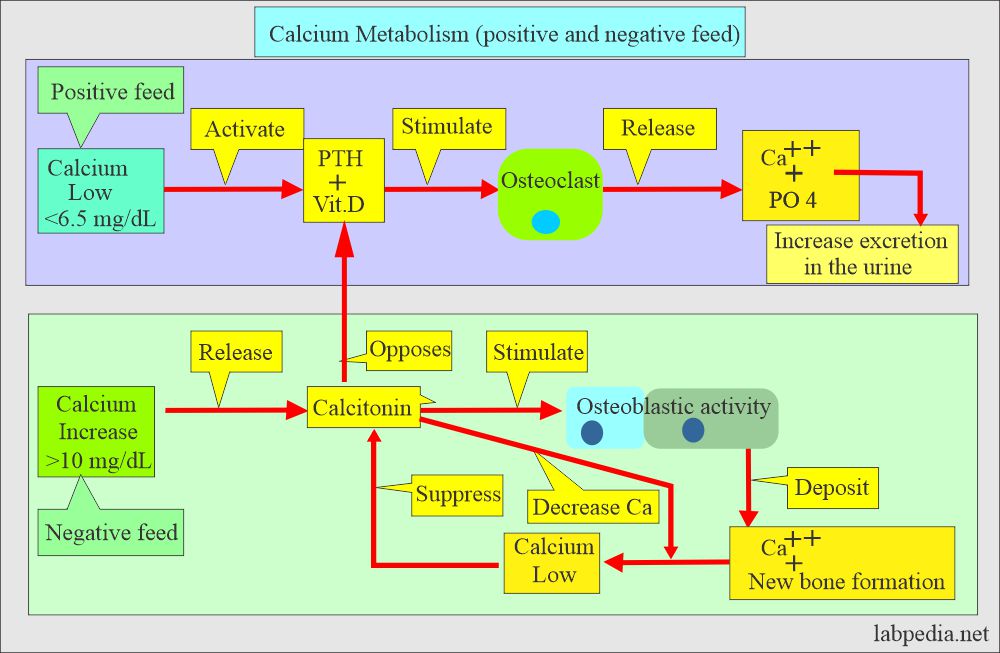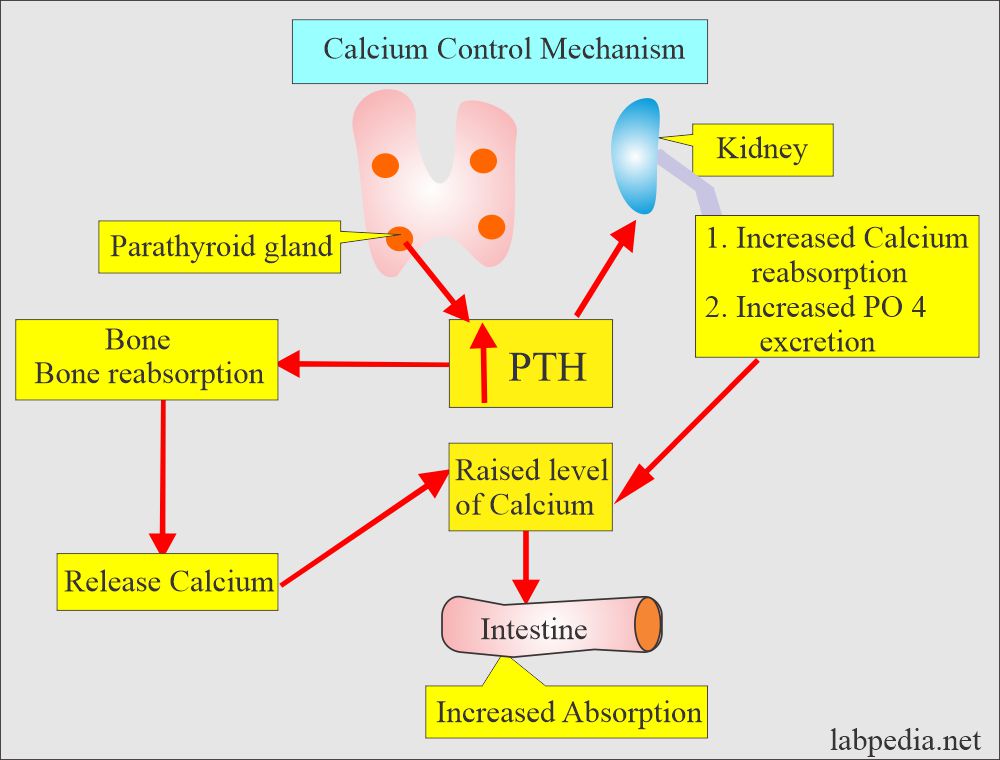Urine Calcium (Ca), (Quantitative 24 hrs urine calcium)
Urine Calcium (Ca)
Sample for Urine Calcium (Ca)
- 24 hours of urine is collected in the acid wash bottle.
- Add 10 to 20 mL of 6M/L HCl.
- 1 to 2 mL of a random urine sample can also be evaluated.
- Refrigerate the urine during collection.
- Or acidify the urine to pH <2.0 to dissolve the calcium salts.
Precautions for Urine Calcium (Ca)
- Wash the bottle with dilute HCl and then rinse with water.
- Avoid contamination with calcium.
- Don’t use cork because it may contaminate the urine.
- If this test is done for metabolic disorders, advise the patient to have a low-calcium diet and stop calcium medications 1 to 3 days before the urine collection.
- For patients with renal stones, the formation should have the same routine diet for the last three days before collecting the urine. Can continue medications.
Indications for Urine Calcium (Ca)
- This is done to evaluate calcium intake (hypercalcemia).
- This also tells the rate of :
- Absorption of calcium from the GI tract.
- Bone Resorption.
- Renal loss.
- Measurement of calcium levels in urine and serum levels is used to diagnose and monitor calcium metabolism disorders.
- This test is also used in the stone evaluation and follow-up.
- Urine calcium is also advised for the calcium intake or rate of intestinal absorption, bone resorption, and renal loss.
Pathophysiology of Calcium (Ca)
- Calcium is the fifth most common element in the body.
- The average human body contains 1 kg of calcium.
- Calcium exists in three forms in the blood.
- Calcium in the body exists as intracellular and extracellular, and both have different functions.
- The parathyroid hormone maintains blood calcium levels.
- PTH indirectly increases the absorption of calcium from the gastrointestinal tract by producing the vit. D.
- PTH increases the serum calcium level by increasing bone resorption and mobilizing Calcium.
- Urine calcium is high in 30% to 80% of primary hyperparathyroidism cases, but it does not diagnostic.
Calcium excretion:
- Mostly calcium is lost in the stool.
- A minimal amount is excreted in the urine.
- In hypercalcemia, there is increased secretion of calcium in the urine.
- In hypocalcemia, there is decreased secretion of calcium in the urine.
- Urinary calcium excretion is dependent upon the dietary intake of calcium.
Increased urinary calcium takes place due to the following:
- Increased intestinal calcium absorption.
- The defect in the renal tubular reabsorption.
- Loss or reabsorption from the bone.
- Or a combination of the above possibilities.
- In primary hyperparathyroid disease, 30 to 80 % of the patient has high urinary calcium.
- Urine calcium does not have much value in the differential diagnosis.
Normal urinary calcium
Source 1
| Diet | mg/day | mmol/Kg/day |
| Infants and child |
up to 6.0 mg/Kg/day |
0.15 |
| Ca-free diet | 5 to 40 | 0.13 to 1.0 |
| Low to average Ca-diet | 50 to 150 | 1.25 to 3.75 |
| Average Ca-diet | 100 to 300 | 2.50 to 7.50 |
- The average Calcium diet is 800 mg/day.
Source 4
- Normal diet = 100 to 300 mg/ 24 hours or 2.50 to 7.50 mmol/day.
- Low calcium diet = 100 to 150 mg /24 hours or 1.25 to 3.75 mmol/day.
Another source
- 50 to 250 mg/24 hours.
False raised values are seen in the following:
- Some of the drugs like calcitonin, vitamins A, K, and C.
- Corticosteroids.
- Urine is taken after meals with a high calcium intake, e.g., milk.
- Increased exposure to sunlight.
- Immobilization, especially in children.
False decreased values are seen in the following:
- Increased ingestion of PO4, HCO3–, and antacid.
- Thiazide diuretics.
- Lithium therapy.
- Alkaline urine.
- Oral contraceptives and estrogens.
Increased urinary calcium:
- In hyperparathyroidism, 30 to 80% of the cases.
- Paget’s diseases.
- Renal diseases.
- Sarcoidosis.
- Breast cancer.
- Urinary bladder cancers.
- Multiple Myeloma.
- Bone metastasis (osteolytic).
- Vit.D intoxication.
- Thyrotoxicosis.
- Osteoporosis.
- Fanconi’s syndrome.
- Idiopathic hypercalciuria.
- Prolonged immobilization.
Decreased urinary calcium:
- Renal osteodystrophy.
- Rickets
- Hypoparathyroidism.
- Pre-eclampsia.
- Vit.D deficiency.
- Metastatic carcinoma of the prostate.
- Preeclampsia.
- Acute renal failure, nephritis, and nephrosis.
- Malabsorption conditions like :
- Celiac disease.
- Sprue disease.
- Steatorrhea.
Questions and answers:
Question 1: How much body contains calcium?
Question 2: What is the role of calcitonin in our body?
Drugs like Thiazide and oral contraceptives leads to decrease level.






Urine calcium spot normal values
That is good for you that spot test for calcium is negative.